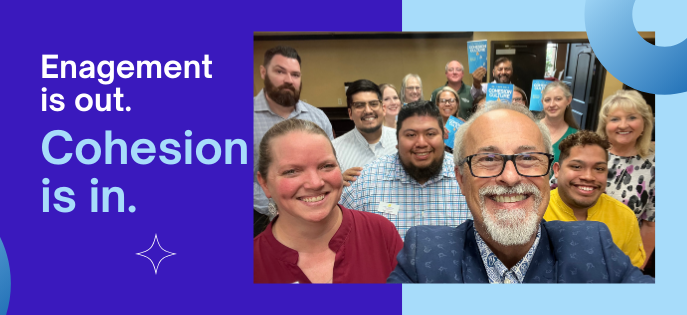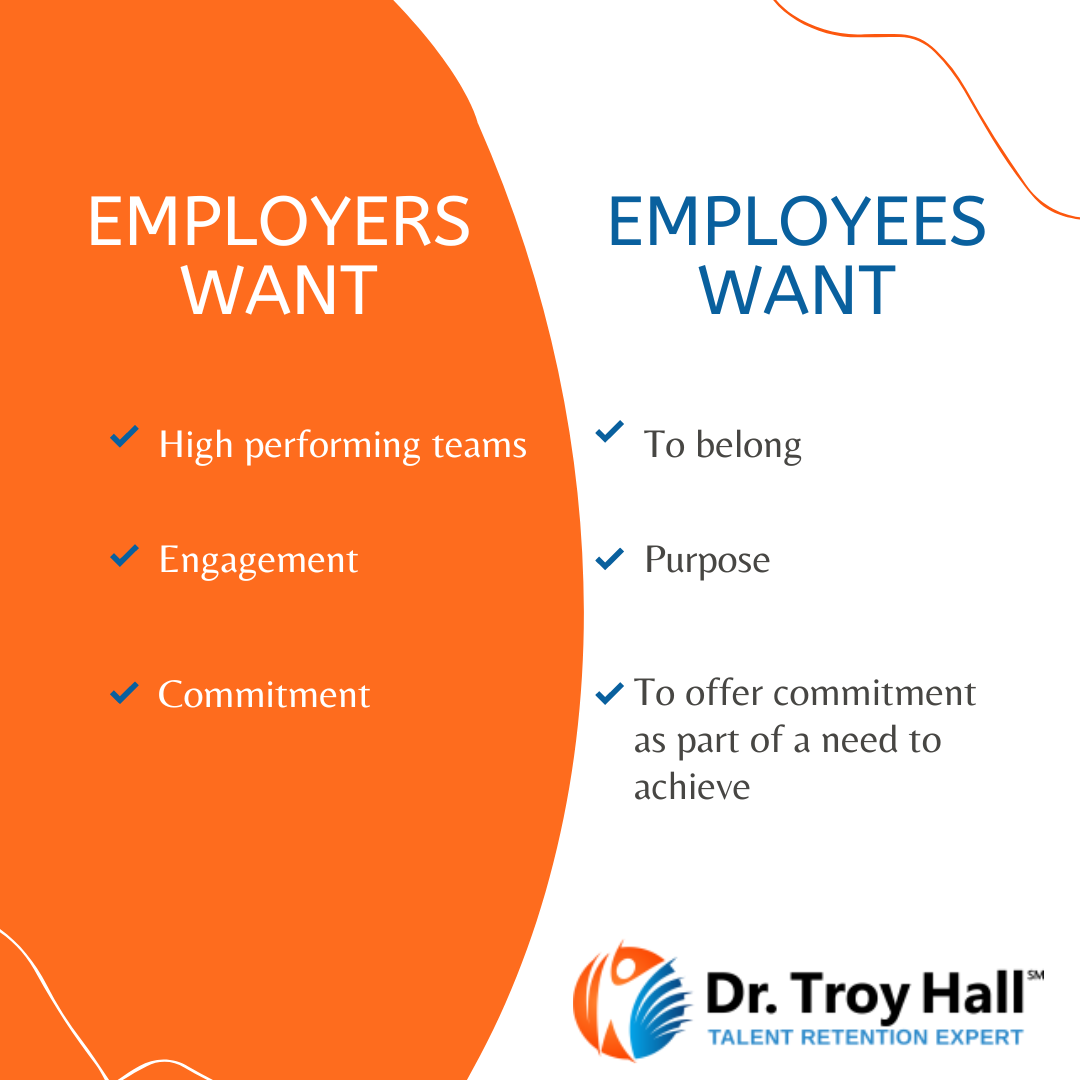
Engagement is Out. Cohesion is In.
In current management circles, the term "engagement" is often misused. Many believe that simply focusing on employee engagement will solve issues related to employee retention. However, this misguided approach can actually have the opposite effect.
In this week's Cohesion Corner™ with Dr. Troy! blog post, I will delve into the misconception surrounding employee engagement and propose a more effective alternative.
Whether intentional or not, employers have been led to believe if they observe certain behaviors as engagement activities long enough, employees will be “all in” and become committed, loyal and long-term contributors.
Looking for committed and engaged employees.
The organizational leader may observe the employee completing tasks with little or no errors, being congenial to teammates, and showing up to work on time. Consequently, these activities, while well intended and portray a positive perspective, do not conclusively mean the employee is engaged. It simply means the leader has observed an employee doing work without exception or delays.
From the outside looking in, these employees seem to demonstrate behaviors that signify they are committed and engaged. Here’s the problem with just relying on empirical evidence from an extrinsic point of view: observations that are not properly measured may lead to a different conclusion than originally perceived; just because employees give the leader a good feeling things are going well, doesn’t mean it’s true.
Not all employees express their inner feelings, and leadership often pays the price when these employees leave for other opportunities.
Imagine a scenario where an employee consistently meets deadlines and interacts positively with colleagues. While these behaviors may seem indicative of engagement, true engagement goes deeper than surface-level observations.
Here are a few examples of employees who may appear engaged on the surface but are actually not fully engaged:
- Task Completers: Some employees consistently meet deadlines and complete their tasks without errors. While this might seem like a sign of engagement, they may lack enthusiasm or passion for their work. They might simply be going through the motions without truly investing themselves in their tasks or the organization's goals.
- Congenial Team Players: Employees who are friendly and get along well with their colleagues may give the impression of being engaged. However, their interactions could be superficial, and they may not actively contribute to team discussions or initiatives. Their friendliness may mask underlying disengagement or lack of interest in their work.
- Punctual Attendees: Employees who always show up to work on time and rarely take time off may be perceived as engaged. However, their consistent attendance does not necessarily indicate genuine engagement. They might be physically present but mentally disengaged, going through the motions without actively contributing or participating in their work.
- Compliance Over Creativity: Some employees follow instructions diligently and adhere to company policies and procedures without question. While compliance is important, employees who prioritize following rules over exercising creativity or critical thinking may lack true engagement. They may be reluctant to challenge the status quo or offer innovative solutions to problems.
- Minimal Contributors: Employees who do just enough to get by and avoid taking on additional responsibilities may appear engaged on the surface. However, their minimal contributions suggest a lack of initiative or investment in their work. They may be content with maintaining the status quo rather than striving for excellence or growth.
It's essential for employers to look beyond these superficial indicators of engagement and seek meaningful ways to measure and foster true employee engagement. This may involve providing opportunities for feedback, recognition, skill development, and alignment with the organization's purpose and values.
Instead, imagine this: a cohesive team working seamlessly together towards a shared goal. That's the essence of true engagement.
Observing behaviors without measurement is inconclusive.
It is important to know that cohesion is a causal phenomenon. Cohesion is not correlational. Cohesion is cause and effort.
My Ph.D. dissertation focused on group dynamics in the realm of global leadership and entrepreneurship. I studied organizational and social behavior to better understand how groups and teams perform. In my research, the dependent variable labeled as performance was studied in relationship to three independent variables that formed cohesion. The variables of belonging, value, and commitment produce a causal phenomenon and affect the outcome of performance. This outcome can be measured.
My dissertation proved the hypothesis that cohesion positively influences performance in all stages of a group’s life cycle.
The level of performance achieved was possible through the efforts of engagement, which include actions such as being:
- Helpful to others
- Active (self-starter)
- Vested (able to see and share the vision)
- Eager (learn and experiment).
Cohesion = Performance = Engagement
Let me illustrate the difference between correlational and causal relationships. Correlational data produces a statistical relationship between two objects. For instance, consider rainy days and umbrellas. When it rains, people do not always open an umbrella. Sometimes they stay indoors or put on a poncho or rain jacket. They may use paper, plastic, or even a book to shield them from the rain. And, what about umbrellas on a beach? When they are opened, does it cause rain? Of course, the answer is no.
Therefore, I can create a statistical relationship between rainy days and umbrellas that can be used by retail organizations to predict how many umbrellas may be sold based on weather conditions. But, correlational data does not predict what will happen between two variables.
However, a causal phenomenon is a catalyst to an effect. My best example is that of gravity. When Newton saw the apple falling from the tree, he investigated and found that gravity caused the object to fall. Without the influence of gravity, the apple would have simply stayed in place whether it had separated from the tree branch or not. His theory established a well-known “cause and effect” scenario. That is the same for cohesion. Whenever cohesion is present (belonging, value, and mutual commitment), you get performance, and that performance is fueled by engagement.
Engagement is actually the outcome of a cohesive team.
Results from my research provided many inward signs to support engagement as an outcome of a Cohesion Culture™. Within a culture of cohesion, employees bring forth their intrinsic feelings and perceptions of reality and set them in motion. Employees who see themselves as an integral part of the organization are aware of their meaning and purpose. This offers accountability as a staple of commitment and engages them at a high level of performance. Fundamentally, the individual’s sense of belonging and alignment with purpose are key drivers to keeping employees at an organization.
Bringing inside out.

We know with assurance that high performing teams produce results consistent with the outcomes associated with engagement. Therefore, I can assert with a level of certainty: “If cohesion causes performance, and performance is engagement, then cohesive teams are engaged.”
In other words, engagement is out; cohesion is in.
To access your free copy of the "Cohesion Culture" book, simply click on the link below:
For more insight on this topic, please refer to these blog posts:
- When Culture Is Broken
- Align Dreams with Company Goals, Don't Steal Them
- Connecting HR and Technology
For leadership principles that can be applied today, click here to subscribe to Cohesion Corner™ with Dr. Troy!
Interested in reading more from Dr. Troy Hall? Check out my books available for purchase on Amazon.






